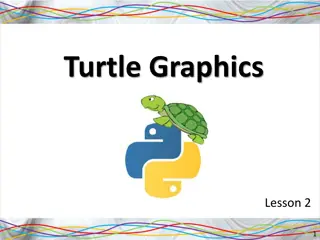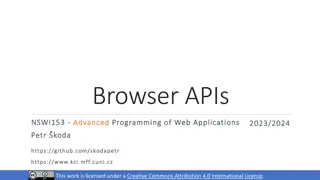Exploring Next-Generation Graphics APIs: Vulkan, D3D12, and Metal
Delve into the world of next-generation graphics APIs like Vulkan, D3D12, and Metal, understanding their importance, differences, and benefits. Discover how these APIs aim to reduce CPU bottlenecks, enhance driver performance, and provide explicit, console-like control for improved graphics rendering.
Download Presentation

Please find below an Image/Link to download the presentation.
The content on the website is provided AS IS for your information and personal use only. It may not be sold, licensed, or shared on other websites without obtaining consent from the author. Download presentation by click this link. If you encounter any issues during the download, it is possible that the publisher has removed the file from their server.
E N D
Presentation Transcript
Next-Generation Graphics APIs: Similarities and Differences Tim Foley NVIDIA Corporation
Next-Generation Graphics APIs Vulkan, D3D12, and Metal Coming to platforms you care about Why do we want new APIs? How are they different?
Why new Graphics APIs? Reduce CPU overhead/bottlenecks More stable/predictable driver performance Explicit, console-like control
CPU Bottlenecks Only single app thread creating GPU work Can become bottleneck for complex scenes Try to do as little on this thread as possible Multi-threaded driver helps a bit New APIs: multi-threaded work creation
Driver Overhead, Predictability App submits a draw call, maps a buffer, etc. Driver might Compile shaders Insert fences into GPU schedule Flush caches Allocate memory
Explicit, Console-Like Control Explicit synchronization CPU/GPU sharing, RMW hazards, etc. Explicit memory management Allocate large memory region at load time Handle sub-allocation in application code
This Talk Bootstrap your mental model Introduce concepts shared across APIs Point out major differences Try to hand-wave the small ones
Big Topics Command buffers Pipeline state objects Tiling Resources / Binding Hazards / Lifetime D3D12 Metal Vulkan
Command Buffers Command Buffers D3D12 Metal Vulkan
Single-Threaded Submission CPU Thread cmd cmd driver cmd GPU Front-End
Writing to a Command Buffer CPU Thread cmd cmd cmd driver GPU Front-End
Submitting a Command Buffer CPU Thread cmd cmd cmd cmd cmd driver GPU Front-End
Submitting a Command Buffer CPU Thread driver Queue cmd cmd cmd cmd cmd GPU Front-End
Start Writing to a New Buffer CPU Thread driver Queue cmd cmd cmd cmd cmd GPU Front-End
CPU-GPU Asynchrony CPU Thread cmd driver Queue cmd cmd cmd cmd GPU Front-End
CPU-GPU Asynchrony CPU Thread cmd cmd driver Queue cmd cmd GPU Front-End
Command Buffers and Queues D3D12 Metal Vulkan ID3D12CommandList MTLCommandBuffer VkCmdBuffer ID3D12CommandQueue MTLCommandQueue VkCmdQueue
Recording and Submitting Record commands into command buffer Record many buffers at once, across threads Submit command buffer to a queue GPU consumes in order submitted
Multi-Threaded Submission CPU Thread cmd CPU Thread cmd cmd CPU Thread cmd cmd CPU Thread cmd Queue GPU Front-End
Multi-Threaded Submission CPU Thread cmd cmd CPU Thread cmd cmd cmd CPU Thread cmd cmd cmd CPU Thread cmd cmd Queue GPU Front-End
Multi-Threaded Submission CPU Thread cmd cmd cmd CPU Thread cmd cmd cmd cmd CPU Thread cmd cmd cmd cmd CPU Thread cmd cmd cmd Queue GPU Front-End
Multi-Threaded Submission CPU Thread cmd cmd cmd CPU Thread cmd cmd cmd cmd CPU Thread done! cmd cmd cmd cmd cmd CPU Thread cmd cmd cmd Queue GPU Front-End
Multi-Threaded Submission CPU Thread cmd cmd cmd CPU Thread cmd cmd cmd cmd CPU Thread CPU Thread cmd cmd cmd Queue GPU Front-End cmd cmd cmd cmd cmd
Multi-Threaded Submission CPU Thread cmd cmd cmd CPU Thread cmd cmd cmd cmd CPU Thread CPU Thread cmd cmd cmd Queue GPU Front-End cmd cmd cmd cmd cmd
Free Threading Call API functions from any thread Not required to have one render thread Application responsible for synchronization Calls that read/write same API object(s) Often, object is owned by one thread at a time
Similarities Free-threaded record + submit Command buffer contents are opaque Can t ship pre-built buffers like on console No state inheritance across buffers
Differences Metal command buffers are one-shot Vulkan, D3D12 allow more re-use Re-submit same buffer across frames Invoke one command buffer from another Limited form of command-buffer call/return Second-level command buffer / bundle
Pipeline State Objects Pipeline State Objects D3D12 Metal Vulkan
State-Change Granularity GL 1.0: the OpenGL State Machine glEnable(GL_BLEND); glBlendFunc(GL_ONE, GL_ONE_MINUS_SRC_ALPHA); D3D10: aggregate state objects d3dDevice->CreateBlendState(&blendDesc, &blendStateObj); ... d3dContext->OMSetBlendState(blendStateObj);
Pipeline State Object (PSO) Encapsulates most of GPU state vector Application switches between full PSOs Compile and validate early Avoid driver pauses when changing state May not play nice with some engine designs
What goes in a PSO? Shader for each active stage Much fixed-function state Blend, rasterizer, depth/stencil Format information Vertex attributes Color, depth targets
What doesnt go in a PSO Resource bindings Vertex/index/constant buffers, textures, ... Some pieces of fixed-function state A bit different for each API
Setting Non-PSO State Set directly on command buffer d3dCommandBuffer->OMSetStencilRef(0xFFFFFFFF); mtlCommandBuffer.setTriangleFillMode(.Lines); Use smaller state objects (Metal/Vulkan) mtlCommandBuffer.setDepthStencilState(mtlDepthStencilState); vkCreateDynamicViewportState(device, &vpInfo, &vpState);
Tiled Architectures and Passes Pass Sequence of draw calls Sharing same target(s) Explicit in Metal/Vulkan Simplifies/enables optimizations Jesse s talk will go in depth D3D12 Metal Vulkan
Memory and Resources Memory and Resources D3D12 Metal Vulkan
Concepts Allocation: range of virtual addresses Resource: memory + layout View: resource + format/usage
Concepts Allocation: range of virtual addresses Caching, visibility, Resource: memory + layout Buffer, Texture3D, Texture2DMSArray, View: resource + format/usage Depth-stencil view,
Memory and Resources D3D12 Vulkan Allocation ID3D12Heap Resource ID3D12Resource VkDeviceMemory VkImage VkBuffer View ID3D12DepthStencilView ID3D12RenderTargetView VkImageView VkBufferView
Resource Binding Resource Binding D3D12 Metal Vulkan
Samplers Textures Buffers Binding Tables GPU State Vector Pipeline State Object
Descriptor GPU-specific encoding of a resource view Size and format opaque to applications Multiple types, based on usage Texture, constant buffer, sampler, etc. Just a block of data; not an allocation
Descriptor Table An API object that holds multiple descriptors Kind of like a buffer, but contents are opaque Table may hold multiple types of descriptors D3D12, Vulkan have different rules on this
Samplers Textures Buffers Descriptor Tables GPU State Vector Pipeline State Object
Pipeline Layout Shaders impose constraints on table layout Descriptor 2 in table 0 had better be a texture Pipeline layout is an explicit API object Interface between PSO and descriptor tables Multiple shaders/PSOs can use same layout
Samplers Textures Buffers Descriptor Tables Root Table Pipeline Layout GPU State Vector Pipeline State Object
Samplers Textures Buffers Descriptor Tables Root Table Pipeline Layout GPU State Vector Pipeline State Object
Descriptor Tables and Layouts D3D12 Vulkan ID3D12DescriptorHeap - VkDescriptorPool VkDescriptorSet D3D12_ROOT_DESCRIPTOR_TABLE VkDescriptorSetLayout ID3D12RootLayout VkPipelineLayout
Data Hazards Data Hazards and Object Lifetimes and Object Lifetimes D3D12 Metal Vulkan
Old APIs: Driver Does it For You Map a buffer that is in use? Driver will wait, or allocate a fresh version Render to image, then use as texture? Driver notices the change, makes it work Allocate more texture than fit in GPU mem? Driver will page stuff in/out to make room























